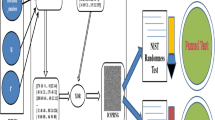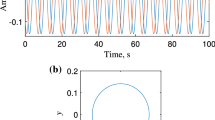Introduction
Random numbers play a key-role in cryptography, since they are used, e.g., to define enciphering keys or passwords [1]. Nowadays, the generation of random numbers is obtained referring to two types of devices, that are often properly combined together: True Random Number Generators (TRNGs), and Pseudo Random Number Generators (PRNGs). The former are devices that exploit truly stochastic physical phenomena [2, 3, 4, 5, 6], such as the electronic noise or the chaotic dynamics of certain nonlinear systems: for these devices the output sequences have an intrinsic degree of unpredictability, that is measured referring to the theoretical tools provided by Information Theory (e.g., in terms of the Shannon entropy) [7,4]. On the other hand, PRNGs are deterministic periodic finite state machines whose aim is to emulate, within the period, the random behavior of a truly random source of numbers. From a theoretical point of view, due to their deterministic nature, PRNGs are potentially predictable by observing their generated sequences [8, 9, 10, 1]. Nevertheless, in literature some families of PRNGs are classified to be ‘secure’, meaning that their algorithmic structure involves calculations that in average, referring to the prediction task, require an amount of computation time that is asymptotically unfeasible with the size of the problem, when referring to both the computational equipment at disposal and the known computing fastest algorithms [1,11]. It is worth noting that a given generator, even if belonging to an asymptotically secure family of PRNGs, can generate short periodic (and unsecure) sequences for several values of the initial seed. Therefore, apart from the cryptographic robustness of their algorithmic structure, a cryptographic PRNG must generate sequences that are acceptable from a statistical point of view, i.e., that pass a certain number of standard statistical tests [1, 12].
Access this chapter
Tax calculation will be finalised at checkout
Purchases are for personal use only
Preview
Unable to display preview. Download preview PDF.
Similar content being viewed by others
References
Menezes, A., Van Oorschot, P., Vanstone, S.: Handbook of Applied Cryptography. CRC Press, Boca Raton (1997)
Petrie, C., Connelly, A.: A noise-based IC random number generator for applications in cryptography. IEEE Transaction on Circuits and Systems I 47(5), 615–621 (2000)
Addabbo, T., Alioto, M., Fort, A., Rocchi, S., Vignoli, V.: A variability-tolerant feedback technique for throughput maximization of TRBGs with predefined entropy. Journal of Circuits, Systems and Computers 19(4), 1–17 (2010)
Addabbo, T., Alioto, M., Fort, A., Rocchi, S., Vignoli, V.: A feedback strategy to improve the entropy of a chaos-based random bit generator. IEEE Transaction on Circuits and Systems – part I 53(2), 326–337 (2006)
Callegari, S., Rovatti, R., Setti, G.: Embeddable ADC-based true random number generator for cryptographic applications exploiting nonlinear signal processing and chaos. IEEE Trans. on Signal Processing 53(2), 793–805 (2005)
Bucci, M., Germani, L., Luzzi, R., Tommasino, P., Trifiletti, A., Varanonuovo, M.: A high-speed IC random-number source for smartcard microcontrollers. IEEE Transaction Circuits and Systems I 50(11), 1373–1380 (2003)
Walters, P.: An Introduction to Ergodic Theory. Springer, Heidelberg (1982)
Boyar, J.: Inferring sequences produced by pseudo-random number generators. Journal of the ACM 36(1), 129–141 (1989)
Plumstead, J.B.: Inferring a sequence produced by a linear congruence. In: CRYPTO, pp. 317–319 (1982)
Knuth, D.: The art of computer programming, 2nd edn., vol. 2. Addison-Wesley, Reading (1981)
Blum, L., Blum, M., Shub, M.: A simple unpredictable pseudo-random number generator. SIAM Journal on Computing 15(2), 364–383 (1986)
NIST Special Publication 800-22 Rev.1a: A statistical test suite for random and pseudorandom number generators for cryptographic applications (April 2010)
Coomes, B., Kocak, H., Palmer, K.: Shadowing in Discrete Dynamical Systems. In: Six Lectures on Dynamical Systems, pp. 163–211. World Scientific, Singapore (1996)
Eichenauer-Herrmann, J.: Pseudorandom number generation by nonlinear methods. International Statistical Reviews 63, 247–255 (1995)
Tezuka, S.: Uniform Random Numbers: Theory and Practice. Kluwer Academic Publishers, Dordrecht (1995)
Eichenauer-Herrmann, J.: Inversive congruential pseudorandom numbers avoid the planes. Mathematics of Computation 56, 297–301 (1991)
Golomb, S.W.: Shift Register Sequences. Aegean Park, Laguna Hills (1982)
Eichenauer, J., Topuzǒglu, A.: On the period length of congruential pseudorandom number sequences generated by inversions. Journal of Computational and Applied Mathematics 31, 87–96 (1990)
Beyer, W.A., Roof, R.B., Williamson, D.: The lattice structure of multiplicative congruential pseudo-random vectors. Mathematics of Computation 25(114), 345–363 (1971)
Boyarsky, A., Góra, P.: Laws of Chaos. Birkhäuser, Basel (1997)
Addabbo, T., Fort, A., Rocchi, S., Papini, D., Vignoli, V.: Invariant measures of tunable chaotic sources: Robustness analysis and efficient computation. IEEE Transactions on Circuits and Systems - I 56(4), 806–819 (2009)
Addabbo, T., Fort, A., Papini, D., Rocchi, S., Vignoli, V.: An efficient and accurate method for the estimation of entropy and other dynamical invariants for piecewise affine choatic maps. International Journal of Bifurcation and Chaos 19(12), 4175–4195 (2009) (accepted)
Setti, G., Mazzini, G., Rovatti, R., Callegari, S.: Statistical modeling of discrete-time chaotic processes: basic finite-dimensional tools and applications. Proc. of the IEEE 90(5), 662–690 (2002)
Stojanovski, T., Kocarev, L.: Chaos-based random number generator – part I: Analysis. IEEE Transactions on Circuits and Systems I 48(3), 281–288 (2001)
Lasota, A., Mackey, M.C.: Chaos, Fractals and Noise - Stochastic Aspects of Dynamics, 2nd edn. Springer, Heidelberg (1994)
Amigó, J., Kocarev, L., Tomovski, I.: Discrete entropy. Physica D 228, 77–85 (2007)
Kocarev, L., Szczepanski, A.J.: Discrete chaos–I: Theory. IEEE Transaction on Circuits and Systems – I 53(6), 1300–1309 (2006)
Addabbo, T., Alioto, M., Fort, A., Pasini, A., Rocchi, S., Vignoli, V.: A class of maximum-period nonlinear congruential generators derived from the Rényi chaotic map. IEEE Transactions on Circuits and Systems - I 54(4), 816–828 (2007)
Addabbo, T., Fort, A., Kocarev, L., Rocchi, S., Vignoli, V.: Pseudo-chaotic lossy compressors for true random number generation. IEEE Transaction on Circuits and Systems I (2010) (accepted) doi: 10.1109/TCSI.2011.2108050
Addabbo, T., De Caro, D., Fort, A., Petra, N., Rocchi, S., Vignoli, V.: Efficient implementation of pseudochaotic piecewise linear maps with high digitization accuracies. International Journal of Circuit Theory and Applications 39(4) (April 2010)
Devaney, R.: An Introduction to Chaotic Dynamical System, 2nd edn. Addison-Wesley, Reading (1989)
Pareschi, F., Setti, G., Rovatti, R.: Noise robustness condition for chaotic maps with piecewise constant invariant density. In: Malek, M., Reitenspiess, M., Kaiser, J. (eds.) ISAS 2004. LNCS, vol. 3335, pp. 681–684. Springer, Heidelberg (2005)
Author information
Authors and Affiliations
Editor information
Editors and Affiliations
Rights and permissions
Copyright information
© 2011 Springer-Verlag Berlin Heidelberg
About this chapter
Cite this chapter
Addabbo, T., Fort, A., Rocchi, S., Vignoli, V. (2011). Digitized Chaos for Pseudo-random Number Generation in Cryptography. In: Kocarev, L., Lian, S. (eds) Chaos-Based Cryptography. Studies in Computational Intelligence, vol 354. Springer, Berlin, Heidelberg. https://doi.org/10.1007/978-3-642-20542-2_3
Download citation
DOI: https://doi.org/10.1007/978-3-642-20542-2_3
Publisher Name: Springer, Berlin, Heidelberg
Print ISBN: 978-3-642-20541-5
Online ISBN: 978-3-642-20542-2
eBook Packages: EngineeringEngineering (R0)




